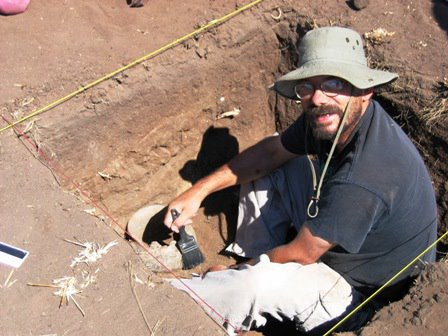While perusing the Rev. Big Dumb Chimp's blogsite I came across his post on an earlier exchange between Carl Zimmer and Casey Luskin over Zimmer's National Geographic article on the evolution of complex features. Part 3 of Luskin's response was very enlightening. He thinks he was showing that Zimmer and National Geographic were not conducting science so much as treading into an area of theology by questioning the capability of an "intelligent" designer. In other words, as Zimmer notes, Luskin (and other ID proponents) are saying that ID is only about detecting the presence of "specified complexity" (design) - move beyond that and begin to question the behavior of the designer, and you've moved beyond science and into the realm of theology, where everyone agrees science must not tread.
Well, with that discussion Luskin demonstrated precisely why ID's use of archaeology's "design detection" as an analogy with biology is misleading at best. Ironically, Luskin also completely castrates Egnor's fraudulent example of design detection using the Antikythera Mechanism, which I previously commented upon. I pointed out then that archaeological research is not about detecting design - in most cases in archaeology we already know items, including things like the Antikythera Mechanism, are made by humans. As Alun Salt expands upon in a similar post on Egnor's misplaced analogy, however, archaeology's "design detection" is understood only because of a body of background experience, observation, experimentation and general hypothesis testing has already informed us that an Acheulian handaxe, for example, was made by early Homo and is not the result of lightning bolts. But that was not always the case: the first encounters with stone tools described their origins as exactly that: formed from lightning - not the result of an intelligent designer! We recognize stone tools (and the Antikyther Mechanism) as designed only because we now know about fracture mechanics, have witnessed aboriginal people making stone tools, understand the development of bronze working and the history of wheels, gears and other already familiar mechanisms. Without that kind of referential knowledge (and a lot more) already in place, even the Antikythera Mechanism would appear as just another natural oddity to avoid stubbing your toe against while tracking that mammoth.
Archaeologists have already done a lot of the hard hypothesis testing behind design detection and have long since moved on to asking question about the designers themselves. But Luskin makes it clear that once design is detected, no more questions are needed - so very unlike archaeology. Archaeology follows the rules of science in its quest for understanding the behavior of the designers behind the arrowhead or the mechanism. It continues to question and accumulate data about the past. ID assumes design is present by comparing itself erroneously with archaeology and then stops. To paraphrase deGrasse Tyson in a previous post, ID is a philosophy of ignorance...archaeology is a philosophy of discovery.
While the "design detection analogy" with archaeology is frequently brought forth as "evidence" for ID it is nothing more than a cheap gimmick that works well with those unfamiliar with crtical thinking and accostumed to watching FOX every night, but has absolutely nothing at all to do with archaeological method and theory. And we can thank Luskin for helping to demonstrate that!
Subscribe to:
Post Comments (Atom)




1 comment:
Re:
Luskin (and other ID proponents) are saying that ID is only about detecting the presence of "specified complexity" (design) - move beyond that and begin to question the behavior of the designer, and you've moved beyond science and into the realm of theology, where everyone agrees science must not tread.
I don't see how they can possibly say they aren't treading there all the damn time. As long as you assume the designer is competent you're making theological arguments. Why couldn't be an incompetent designer? One that screwed a lot of things up (I can think of a few). Clearly life and the world isn't perfect, but it seems so important to them to assert that designs are perfect and purposeful.
It becomes imminently clear who they think the designer is. As long as they pretend that it is scientific because they're not asserting a specific designer, their intellectual dishonesty will be apparent.
Post a Comment